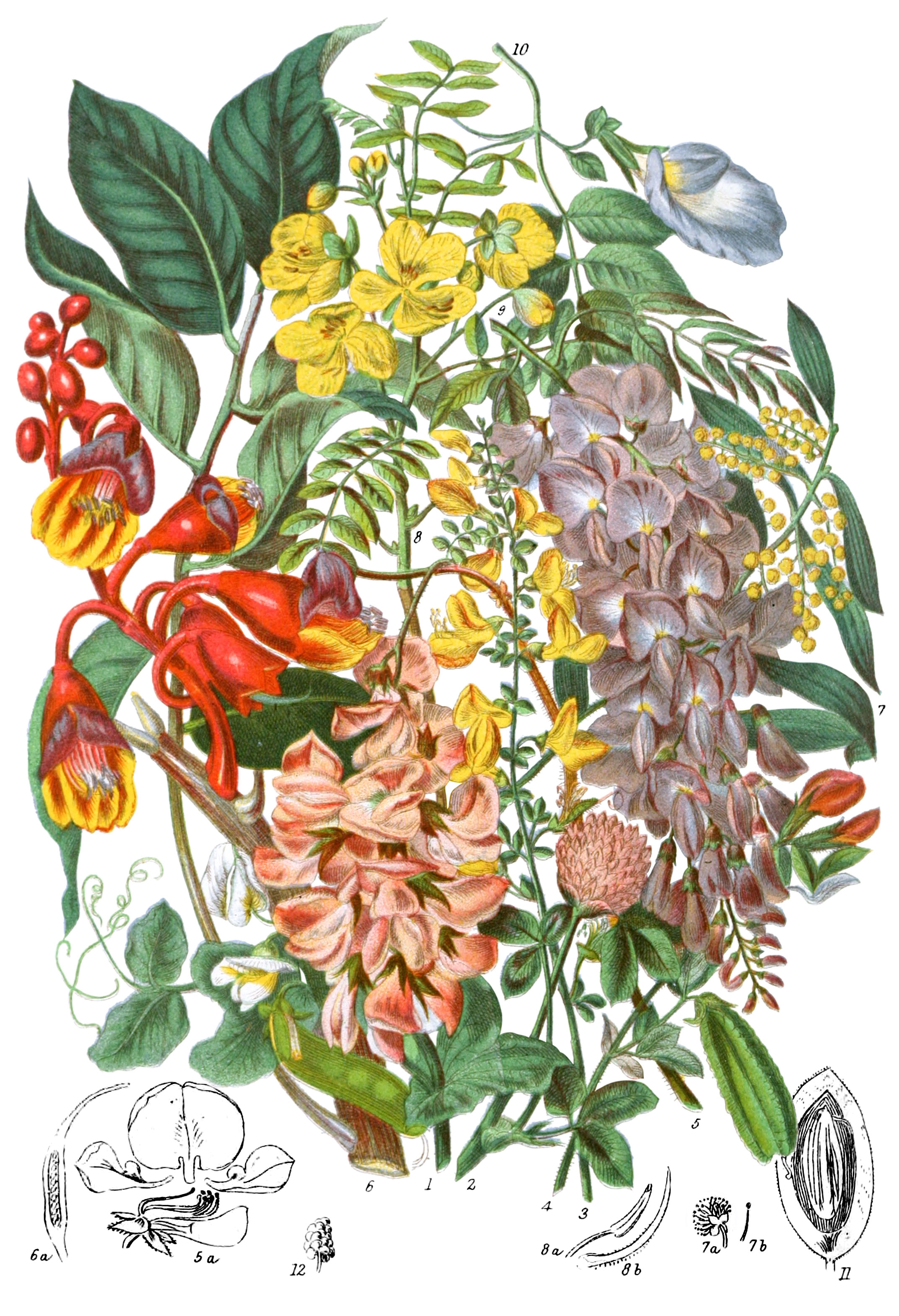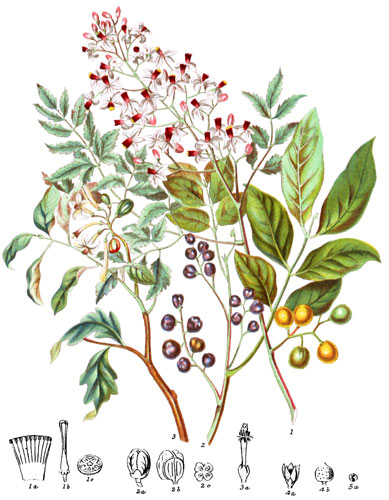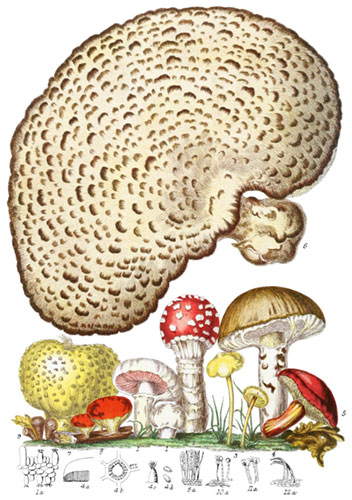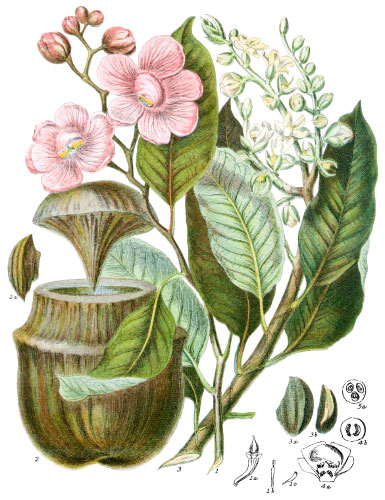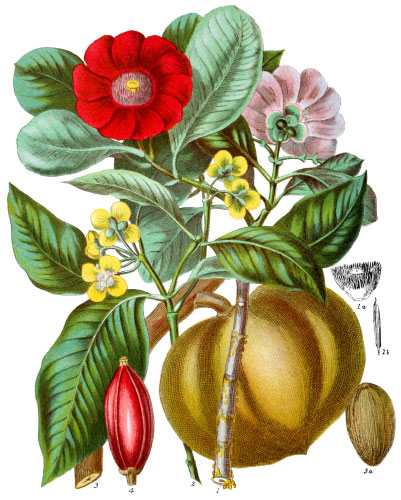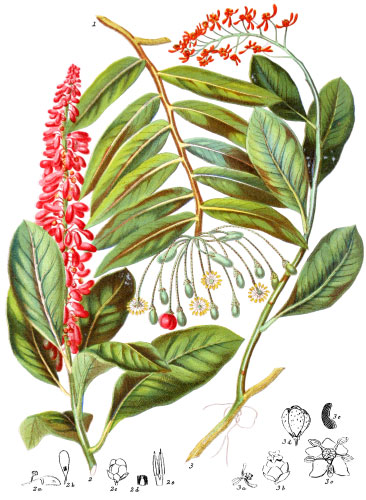Key characteristics
Trees, shrubs, and herbaceous plants, of extremely various aspect. The leaves are alternate, generally compound, having a pair of stipules at the base of the leaf-stalk, and at each leaflet. The flowers are usually papilionaceous, some are spreading and regular; the calyx is below the ovary, five parted, often unequally so, the odd segment place din front. The petals are five, inserted into the base of the calyx, the upper one forming the standard, the one on either side of the wings, the two lower combinedinto the keel, enclosing the stamens and pistil. The stamens are of definite or indefinite number, usually attached to the calyx, either distinct or united into one or two sets, very rarely into three. The pistil is simple, one-celled, or many-seeded, commonly consisting of a single carpel, occasionally of more; the style and stigma are simple. The fruit is a legume, or a drupe, as in Dipterix (11); the seeds are fixed to the upper seam, solitary or several, without albumen.
This Tribe has most affinity with Rosaceæ; the position of the odd lobe of the calyx and the leguminous seed-vessel are distinguishing characters.
This remarkable Tribe is amongst the most important to man, contributing a large portion of embellishment to the earth, yielding excellent timber, the most useful of all dyes, indigo and logwood, bark for tanning, gums, resins, balsams, medcines, and although in general containing deterious juices, yet many species afford an abundant supply of wholesome nutriment in the pulse of the seeds to men and animals. The seed-vessel is developed in diverse forms of pod: in some of the South American trees it is of enormous size and solid woody substance; when ribe, bursting, and the large seeds falling to the ground with considerable noise.
Select plants in this order
Not all plants listed are illustrated and not all plants illustrated are listed.
- Pisum sativum (1) is of ancient renown and extended use throughout Europe.
- Trifolium (2) was known to the Greeks, and has ever been esteemed as food for cattle. Several kinds of Vetch are valuable as fodder.
- Spartium (3) is one of the most ornamental of European shrubs, adorning the wildest ground with its golden flowers, rivalled only by the still more hardy Ulex, the Furze, which is, however, of more limited distribution.
- The species of Spartium called Ratama, nine feet in height, covers the sandy ridges of the Peak of Teneriffe at an elevation of 9000 feet, until the barren pumice and lava impede vegetation; the flowers are highly odoriferous, and the fine brown goats that feed on it are considered of very superior quality.
- The Winged Pea (4) was formerly eaten by the peasants of Sicily and Spain.
- Robinia hispida (5) is a beautiful, but very fragile shrub; a variety with tougher branches is extremely ornamental to the public walks of many German towns.
- R. pseudacacia, the Locust-tree of North America, is much planted here for the sake of its wood, which is said to last one hundred years as gate-posts.
- Acacia Sophoræ (7) belongs to an extensive genus, with small spreading flowers, having the stamens and pistil separated, yielding gums, delicious perfumes, and astringent bark in Arabia and Egypt. Some species afford useful wood. The compound leaves of these shrubs have a peculiar tendancy to diminish, gradually falling away, till the apparent leaves are in reality only the expanded leaf-stalk, as in A. Sophoræ.
- The chief vegetation of the Arabian Deserts belongs to this Tribe, Acacia vera and arabica exuding the well-known gum; Alhagi, the Camel’s thorn, and other low, thorny, balsamiferous shrubs, are scattered over the scorched dreary tracts.
- Mimosa sensitiva and pudica possess an extraordinary irritability, when touched at the top of the leaflets each pair closes in succession.
- Cassia (8) is a genus comprising the medicinal Senna, the product principally of African species.
- Among the lofty trees, one of the most striking is Alexandra (6), discovered by Sir Robert Schomburgk on the shores of the Cuyuni and Guiana: the graceful stem attains 120 feet in height, and the rich dark foliage, thickly interspersed with brilliant flowers, has a very splendid appearance: the pod is nearly two feet in length, and the seed as large as a chesnut.
- Wistaria (9) has now become acclimatised in England, producing its countless blossoms in spring on the leafless branches, which can be led horizontally to the extent of eighty feet from the stem.
- The seeds of Ceratonia siliqua, the Carat-tree of the East, are said to have furnished the original carat weight for jewels; they are now used as food for horses in Spain.
- Gum Tragacanth of Syria and Persia is produced by several shrubby thorny kinds of Astralagus, a genus of which only herbaceous species are natives of England.
- Crotalaria juncea furnishes the coarse Bengal hemp for canvas bags.
- The wood of Hymenea Courbaril of South America is one of the heavest class, a cubic foot weighing 100 lbs., whilst that of Laburnum, although fine-grained, weighs only 52 lbs.
- Among the most useful roots of these plants, that of Glycyrrhiza Liquorice, is included.
- Indigo is now chiefly grown in South America but is one of great antiquity in the East Indies; an ancient Sanscrit writing mentions “the vat of a dyer filled with indigo, a jackal falling into it was coloured blue.”
Locations
This Tribe is distributed in unequal proportioins in every part of the known world, except in the Isles of St. Helena and Tristan d’Acunha: in the Tropics more than 1600 species have been discovered; thence the numbers gradually diminish north and south: the largest portion are natives of South America: in the countries bording the Mediterranean a considerable number exist.
Legend
- Pisum sativum, Eatable Pea. S. Europe.
- Trifoium pratense, Purple Clover. Britain.
- Spartium scoparium, Common Broom. Britain.
- Tetragonolobus edulus, Winged Pea. Sicily.
- Robinia hispida, Rose Acacia. Carolina.
- Flower, separated.
- Alexandra imperatricis. Guiana
- Section of Ovary.
- Acacia Sophoræ. Tasmania.
- Stamen Flower.
- Stamen.
- Cassia Australis. Australia.
- Stamen.
- Pistil.
- Wistaria sinensis. China.
- Clitoria Ternatea. Moluccas.
- Drupe of Dipterix Tonga, Fragrant Tonga Bean.
- Seed-vessel of Medicago lupulina.
Explore more
Posters
Decorate your walls with colorful detailed posters based on Elizabeth Twining’s beautiful two-volume set from 1868.
Puzzles
Challenge yourself or someone else to assemble a puzzle of all 160 botanical illustrations.
